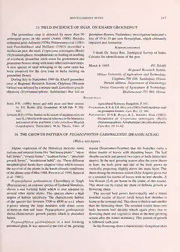
Field incidence of snail on Kharif groundnut PDF
Preview Field incidence of snail on Kharif groundnut
) MISCELLANEOUS NOTES 287 FIELD INCIDENCE OF SNAIL ON KHARIF GROUNDNUT 33. The groundnut crop is attacked by more than 90 groundnut flowers. Preliminary investigation indicated a arthropod pests in the world (Amin 1988). Besides loss of 10 to 15 per cent flower/plant, which ultimately arthropod pests Adimani (1976); Puttaswamyetat. (1981 impaired pod formation. and Panchabhavi and Hullatti (1983) recorded a Acknowledgement molluscan pest, the snail, Cryptozona semirugcita (Beck) I thank Dr. Surya Rao, Zoological Survey of India, (Stylommatophora: Ariophantidae) as feeding on seedling Calcutta for identification of the pest. of soyabean, groundnut seeds sown for germination and groundnut flowers along with many othercultivatedcrops. March 1995 PC. DASH A new species of snail belonging to the same order has 8, Regional Research Station, been observed for the first time in India feeding on groundnut flower. Orissa University ofAgriculture and Technology, During July to September 1989 the Kharif groundnut Chiplima-768 026, Sambalpur, Orissa. crop at Regional Research Station, Chiplima (Western Present address: Department ofEntomology, Orissa) was infested by a minute snail,Lamellaxisgracile Orissa University ofAgriculture & Technology, (Hotton) (Stylommatophora: Sublinidae) that fed on Bliubaneswar-751 003, Orissa. References Amin, P.W. (1988): Insect and mite pests and their control. Agricultural Sciences, Bangalore, P. 167. In: P.S. Reddy (Ed) Groundnut, ICAR Pub. P. 392- Panchabhavi, K.S. & V.B. Hullatti (1983): Fieldincidencesnail 452. on groundnut kernels. Curr. Res. 12: 106. Adimani, B.D.(1976): Studiesontheinsectsofsoyabean(Glycine Puttaswamy, D.N.R. Reddy & L. Krishna Naik (1981): max(L.) Merril)with special reference tothebionomics Occurrence of Cryptozona semirugata (Beck) and control ofthe pod borer, Cydia patychora Meyrick (Stylommatophora: Ariophantidae)on cultivated plants. (Lepidoptera: Torticidae). M.Sc Thesis, Univ. of Curr. Res. 10: 61-62. THE GROWTH PATTERN OF PEGAEOPHYTON GARHWALENSIS (BRASSICACEAE) 34. (With a text-figure ) Alpine vegetation of the Himalaya includes some season (September-October) that the branches carry a curious and unusual forms like “hot house plants”, “snow dense rosette of leaves with sheathing bases. The leaf ball forms”, “rosette forms”, “cushion forms”, “prostrate sheaths encircle and protect two types ofbuds (telescopic growth forms”, “acaulescent habit”, etc. These different shoots). In the next growing season after the snow-thaws morphological forms have adaptive value which ensures in June, the buds grow and one of the buds grows up the survival ofthe plants in the harsh climatic conditions vertically projecting slightly above the moss layer. This ofthe alpine zone (Ohba 1988,Rawatetal. 1994, Semwal shoot during the monsoon season (July-August) gives rise et al. 1981). to a terminal lax rosette of leaves with no leaf sheaths. A Pegaeophyton garhwalensis Chowdhery et Singh few flowers (2-4) are borne in the centre of this rosette. (Brassicaceae), an endemic species ofGarhwal Himalaya, This shoot can be called the shoot of definite growth or shows a mat forming habit which is also adopted by flowering shoot. several other alpine plants. This species shows a high The second bud grows horizontally and a dense degree of habitat specificity. The characteristic habitat terminal rosette of leaves (with broad leaf sheaths) is m of the species lies between 3700 to 4800 a.s.l. where borne at the terminal end. This shoot is thickerand smaller it grows among the large boulders with dense cover than the flowering shoot. The terminal rosette bears two ofmoss on thin soil layer. Pegaeophyton garhwalensis buds between leaf sheaths which again gives rise to shows characteristic growth pattern which is described flowering shoot and vegetative shoot in the next growing below. season after the winter dormancy. This pattern of growth Pegaeophyton garhwalensis is a mat forming is followed each year. perennial plant. It was noticed at the end of the growing In the flowering shoot a characteristic elongation takes
